The 2024 global art recap reflects a year of evolution, marked by shifts in market dynamics, technological advancements, and a heightened focus on sustainability. As the art world adapts to complex economic and cultural landscapes, several transformative trends are shaping its future. These developments are not only redefining how art is created and experienced but also expanding its impact on society and the environment. Amid economic challenges, the market has shown resilience; while overall sales have dipped, certain segments continue to grow, underscoring the art industry’s adaptability and enduring relevance.
The first three quarters of 2024 have been exhilarating for the global art scene, with groundbreaking exhibitions, inventive artistic expressions, and thought-provoking collaborations. Contemporary art galleries and artists are pushing creative boundaries to address crucial social, political, and environmental issues; the year has already delivered numerous remarkable moments. The rise of digital and AI-generated art has further unlocked new realms of creativity and investment.
This overview explores the events and developments that have defined the art world so far, offering insight into how art continues to inspire and challenge audiences globally.
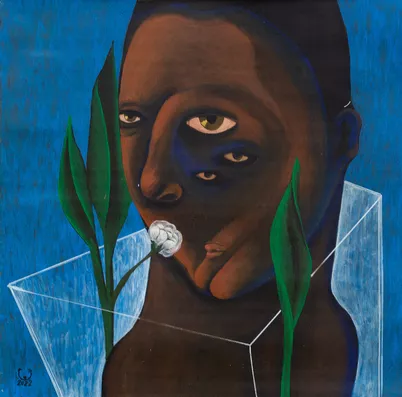
1. Market Trends & Sales:
The Art Basel and UBS Global Art Market Report 2024 highlights a slowdown in sales while emphasizing the market’s overall resilience. During the first half of 2024, the art market experienced a significant slump, with the total spending on fine art at auction dropping to $5.05 billion—a 29.5% decrease compared to the same period in 2023. Ultra-contemporary works, particularly those by artists born after 1974, saw a sharp 39% decline in sales, totaling $164.8 million. The market has struggled to regain equilibrium since its peak in 2021, facing a collapse in resale prices that has led to adjustments in market pricing and increased willingness among galleries to negotiate. As an example, a Phillips auction in New York on the 17th of July, 2024, offered works by well-known artists like David LaChapelle, Sam Gilliam, and Wendy Park without reserves, indicating that their owners were willing to sell at any price. Similarly, the nearly 80-year-old Marlborough Gallery, a prominent blue chip gallery, shut its doors in June due to shifts in the sector and internal politics.
Despite this trend, the United States remains a dominant force in the art market, holding 42% of global sales, despite a 10% decrease in overall sales value. Contemporary art, critical to market vitality, has reached a new high, with sales being at the $1.88 billion mark and transaction volumes hitting record levels – this resurgence signals a return to pre-COVID performance levels. The number of contemporary artworks sold at auctions has more than doubled over the past decade, driven largely by accelerated digitalization since the COVID pandemic. This shift has significantly broadened market access, resulting in a remarkable 72% surge in sales compared to pre-pandemic levels.

Auction:
Some observers describe the art market as tanking. The avalanche of financial troubles that have plagued the global art market have also touched the London art scene where, according to the Financial Times (although disputed by a spokesperson from the auction house), Sotheby’s core earnings went down by 88% with a reported net “long-term debt” of more than $1.8 billion which will thankfully be reprieved by the $1 billion fund acquired from Abu Dhabi’s sovereign wealth fund (ADQ) who now has a minority stake in the auction house, and will thus “reduce leverage.” In the same vein, lay-offs are in sight as the top auction house is set to dismiss about fifty employees at its London offices, with cuts likely at other locations in Europe and New York. Major galleries have experienced losses, notably Christie’s, which reported $2.1 billion in sales, down from $2.7 billion at this time last year, and the Galerie Thomas, which filed for bankruptcy.
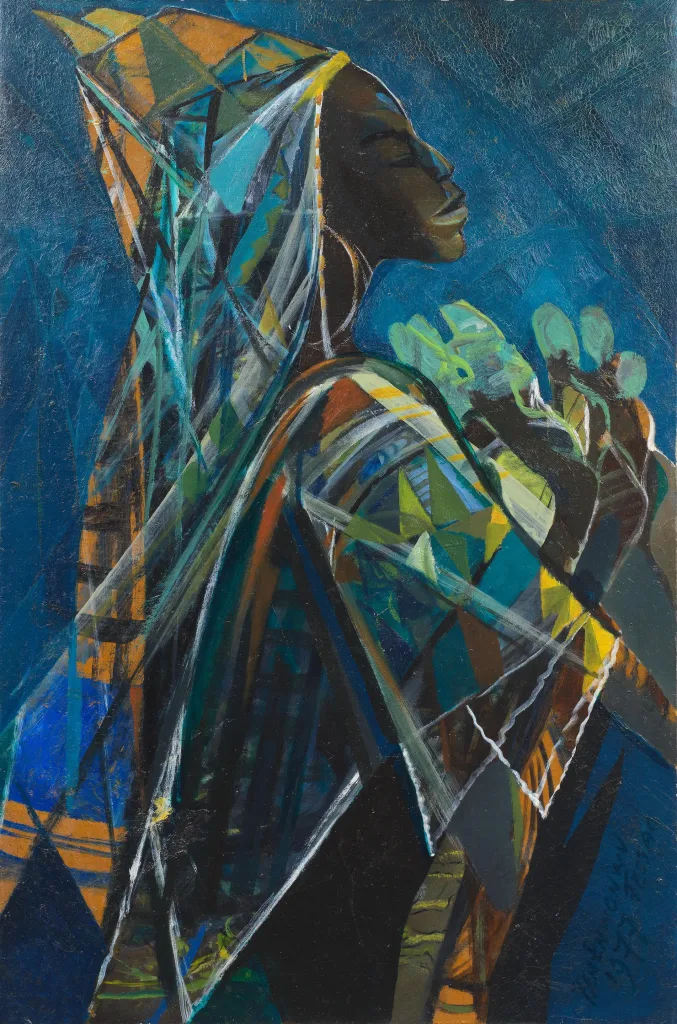
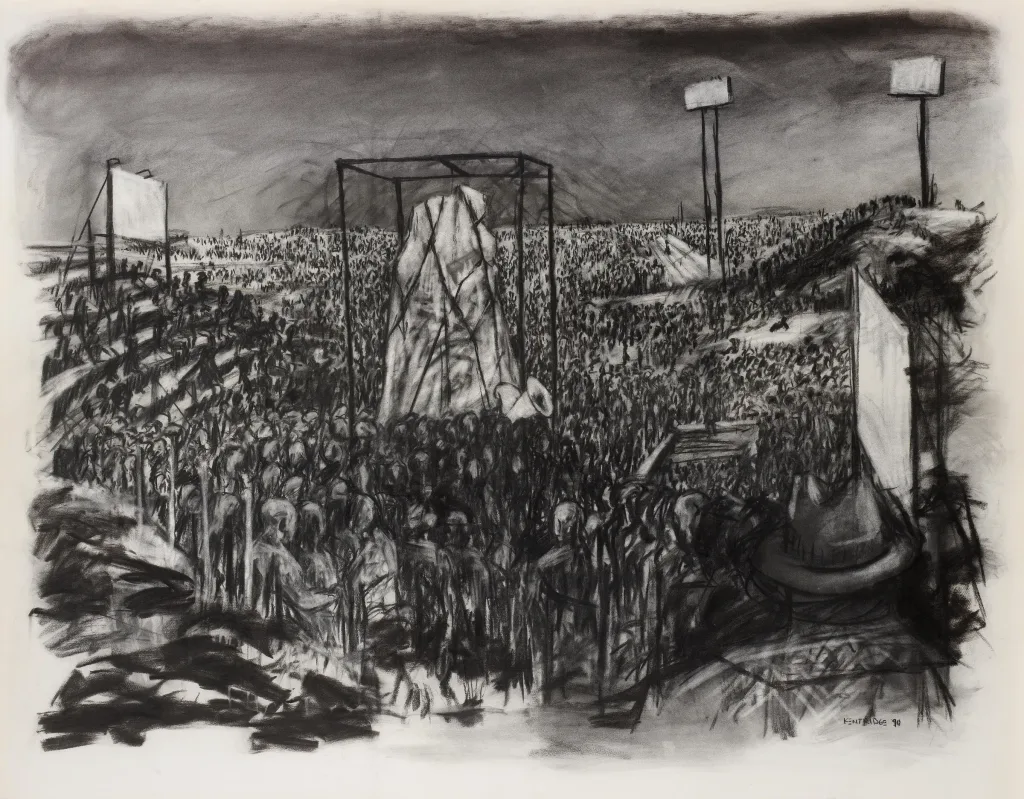

Conversely, the Bonhams’ Modern and Contemporary African Art auction on March 27, 2024, yielded impressive results. Nigerian artists led the pack, with Benedict Enwonwu’s Portrait of Tonkin Jackson (framed) selling for £381,400 and hisYoruba Drummers (1974) going for £152,800. Demas Nwoko’s Terracotta Figure followed with £63,900. Meanwhile, Ethiopian-Armenian artist, Alexander “Skunder” Boghossian and Ethiopian Elias Sime also made significant contributions, with their works Timkat and Migueb 1, Min Neber (What is it) respectively selling for £28,160. Bonhams’ October 16, 2024 auction featured a standout lineup, with its top three sales belonging to renowned African artists. Nigerian master Benedict Chukwukadibia Enwonwu’s Festac ’77 sold for £444,900, surpassing estimates. Similarly, South African artist William Kentridge’s Monument I and South African-British Marlene Dumas’ Billy Holiday (1993) achieved impressive hammer prices of £483,000 and £152,800, respectively – significantly exceeding predicted sale values.
On a turn of events, the high-end segment of the contemporary art market faced a notable slowdown. Sales of works priced above $50,000 contracted by 21%, resulting in 1,150 fewer transactions. Although this decline may seem minor against the 132,000 total lots sold, it had a substantial impact on overall turnover, translating into several hundred million dollars less in revenue. Additionally, the number of high-value sales, which peaked at 372 lots two years ago, dropped to just 224 in 2023/2024.
Women: Women are finally gaining long-overdue recognition in the art world. In August, Victoria Siddall made history as the first female director of London’s National Portrait Gallery. Meanwhile, Skulptur Projekte appointed an all-female directorial collective— Ivet Ćurlin, Nataša Ilić, and Sabina Sabolović—marking another significant step forward. Additionally, the Deutscher and Hackett’s Important Australian + International Fine Art Melbourne auction on the 28th of August, 2024, saw female sculptors winning big with Bronwyn Oliver’s sculptures, Clasp and Flow, at Lot 12 and 13 respectively selling for nearly $1 million combined: $515,455 and $466,364 accordingly. Remarkably, this auction sale generated about $7.4 million.

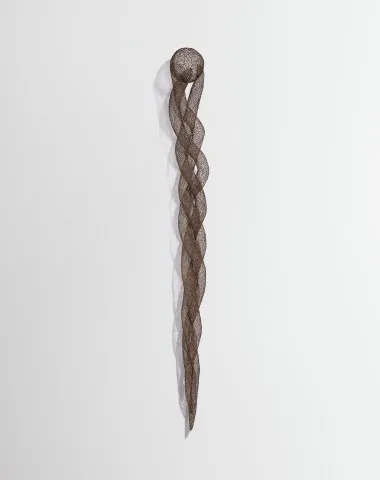
Equally, the 2024 Contemporary Art Market Report by Art Price reveals a seismic shift in the Ultra-Contemporary scene: women artists are decisively taking center stage. This isn’t just a nod to equality; it’s a full-throated celebration of female creative power. An impressive seven out of the Top Ten Selling Artists Under 40 (Ultra-Contemporary artists) are women, including Jadé Fadojutimi, Lucy Bull, Avery Singer, Loie Hollowell, Issy Wood, Christina Quarles, and Ewa Juszkiewicz. These women, alongside three male counterparts, generated $59 million in sales, accounting for 40% of the Ultra-Contemporary market’s value from a mere 145 lots, or less than 2% of total transactions. This significant presence and financial success signal a substantial increase in recognition and appreciation for women artists in the contemporary art world.

Young Talents: In addition, driven by auction houses’ proactive promotion of young talents, the Ultra-Contemporary art market has undergone a remarkable transformation since the millennium. Based on reports from the Artprice’s 2024 Contemporary Art Market Report, this strategic push has led to an explosive growth in sales, with over 3,000 artists Under 40 recording sales in the past year – a six-fold increase from 500 in the early 2000s. Top galleries like Gagosian, Hauser & Wirth, and David Zwirner have played a pivotal role in nurturing millennial artists, catapulting them to international acclaim. As a result, Ultra-Contemporary art has become a powerhouse, generating nearly $150 million annually – 100 times more than 20 years ago. With 8,830 works exchanged and collectors eagerly seeking affordable pieces, the demand for young artists’ work remains unwavering, solidifying their position as the “new guard” in the art world. It is important to note that offline art sales—through galleries, art fairs, and auction houses—continue to dominate the marketplace for high-value art.
2. Art Fairs:
According to the Art Basel and UBS Art Market Report by Dr. Clare McAndrew and Arts Economics, for art fairs in 2024, the changing pattern of sales has been influenced by differences in gallery exhibitions and art fairs dealers that have engaged in over the last few years. Despite a strong bounce-back in 2022, the number of art fairs remains lower than pre-pandemic levels, with 359 fairs in 2023 compared to 408 in 2019. Dealers plan to participate in the same number of art fairs in 2024, averaging four, with 39% expecting sales increases, 46% anticipating stable sales, and 14% predicting declines. The 2024 art fair landscape will be shaped by rising costs, changing sales patterns, increased competition, and digital tool importance, influencing dealer strategies and art market dynamics.
The Armory Show:
Held from the 5th to 8th of September 2024, the Armory Show concluded on a high note, with steady attendance and sales throughout the weekend. Defying traditional patterns, major transactions occurred on the Saturday and Sunday of the event, rather than during the preview. Mihai Nicodim, owner of Nicodim Gallery, noted that buyers approached purchases thoughtfully, seeking art that resonated with them. Victoria Miró sold five of Isaac Julien’s video installations priced between $350,000-$450,000, and some of Julien’s photographs priced between $40,000-$80,000.
On the same subject, emerging art priced under $10,000 experienced significant success at the Armory Show. Half Gallery sold eleven out of the fifteen works displayed that were within the $10,000-$30,000 price range; and Mrs.Gallery saw robust sales of Alexandra Barth’s paintings ($3,500-$13,000), with Barth winning the TPC Art Finance Presents Prize.

By Sunday, James Cohan had secured notable sales, including 3 of Naudline Pierre’s oil paintings and 2 of her acrylics for $109,000. Additional sales includes Eamon Ore-Giron’s paintings at $50,000 each, Jordan Nassar’s embroidered works at $34,000 each, and Alison Elizabeth Taylor’s piece for $22,000. In like manner, Night Gallery reported strong demand for Sarah Miska’s close-up paintings, selling two pieces for $48,000 each, two for $32,000, and one for $16,000. The gallery also placed works by Nigerian-American Anthony Olubunmi Akinbola for $40,000.
Notable African galleries at the show included Kó, SMAC, and WHATIFTHEWORLD. Kó highlighted works by Na Chainkua Reindorf and Ato Ribeiro, while WHATIFTHEWORLD exhibited pieces by Chris Soal—some sold, some on hold, and others available upon request.

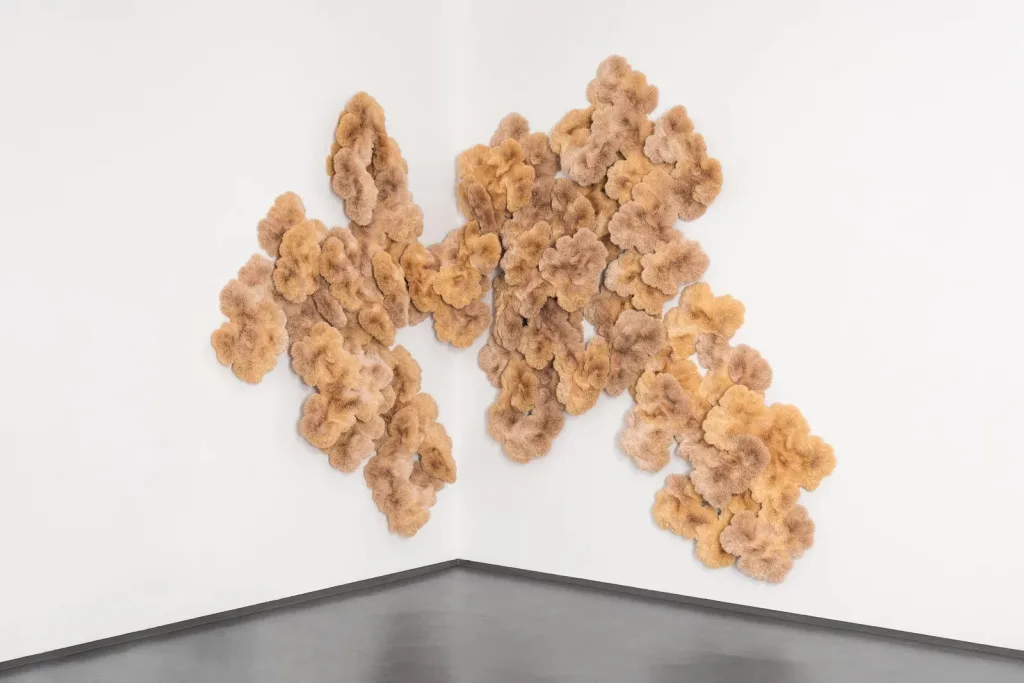
Art Paris 2024 Fair:
Art Paris 2024 held from the 4th to 7th of April, 2024, at the Grand Palais Éphemère and it brought together 136 galleries from around the world. This year’s edition highlighted the richness of regional and cosmopolitan artistic identities, showcasing carefully curated selections from Europe, Asia, Africa, and the Americas. The fair featured thought-provoking exhibitions exploring contemporary creation, multiethnicity, and the hybridization of forms and cultures. The “Promises” sector provided a platform for emerging artists, with over 20 galleries participating at reduced exhibitor fees. In line with its eco-friendly commitment, Art Paris prioritized local transport solutions and minimized its carbon footprint, underscoring its dedication to environmental responsibility. Looking ahead, Art Paris 2025 promises to be an unforgettable event, scheduled to take place from the 3rd to the 6th of April, 2025.
Art Basel 2024:
Art Basel 2024, held from the 13th to 16th of June, 2024, and it brought together 285 galleries representing 40 countries under the curation of Stefanie Hessler, director of the Swiss Institute in New York. The event highlighted a broad spectrum of artistic expressions across various mediums and styles, drawing more than 100,000 visitors. Notably, the fair saw several seven-figure sales, cementing its role as a key moment in the global art market. French artist Jean-Michel Othoniel (at Perrotin gallery) stunned audiences with his solo presentation, Othoniel: Noeuds Sauvages, exploring emotional geometry through intricate mirrored glass and stainless steel sculptures inspired by knot theories and symbolic flowers.
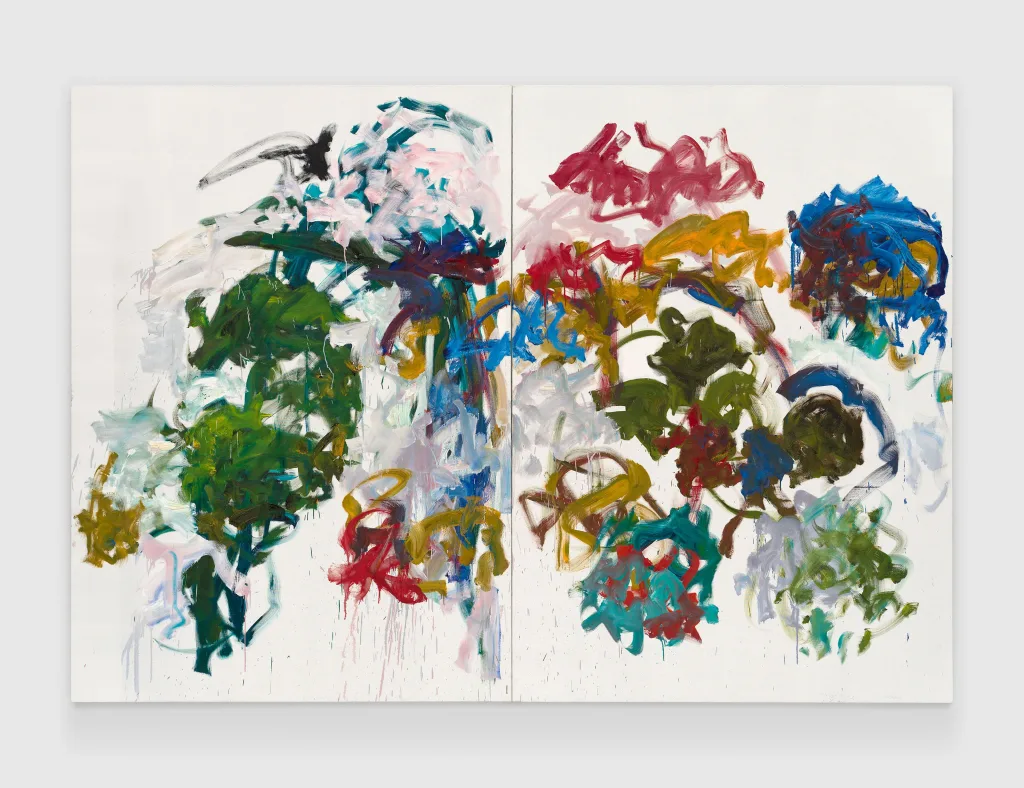
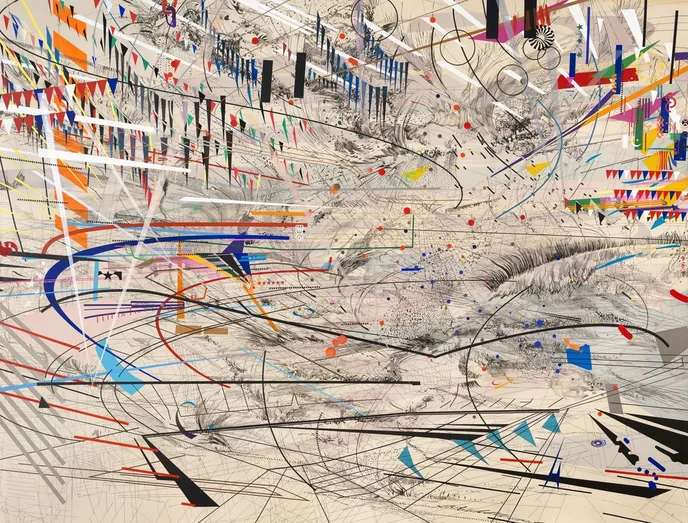
David Zwirner leads the charts with the most valuable reported transaction from the fair – Sunflowers (1990–91) by Joan Mitchell which sold for $20 million. Following this number is Ashley Gorky’s Untitled (Gray Drawing (Pastoral) (1946-47) which sold for $16 million. On a similar note, Ethiopian-American Julie Mehretu’s Untitled 2 (1999) sold for $6.75 million, reaching the pinnacle of White Cube sales.
Art Basel Paris 2024:
It occurred on the 18th to 20th of October, 2024, and featured 195 galleries with its three sectors and initiative. Galleries, the main exhibition sector, comprised of galleries specializing in Modern and contemporary art across various mediums including paintings, sculptures, installations, photography and digital art. It recorded galleries like the Fitzpatrick Gallery, Gagosian, David Zwirner and Goodman Gallery. Emergence gathered exhibitors presenting young and emerging artists through their solo presentations. This featured artists like Pierre Allain from Petrine, Steffani Jemison from Madragoa and Kei Imazu from ROH Projects. In Premise, the newest section, nine galleries presented highly singular curatorial proposals that may include work made before 1900, with artists like Mohamed Melehi (1936-2020) from the Moroccan Loft Art Gallery, and Janet Sobel (1893-1968) from The Gallery of Everything.
Finally, Oh La La! a new initiative, called on exhibitors to present their seldom seen work in their booth for 48 hours, on Friday, October 18 and Saturday, October 19; and galleries like the Lehmann Maupin and the Selma Feriani featured here.

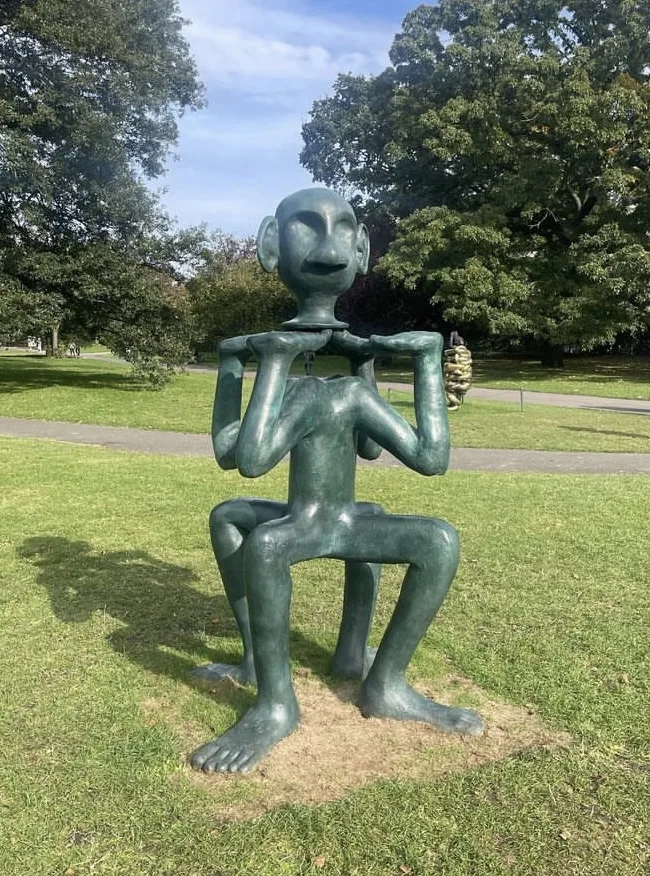
Frieze (London) 2024:
The Frieze Masters and Frieze London took place on the 9th to 13th of October, 2024, and notwithstanding the difficulties observed in the global art market, they achieved remarkable sales figures. At Frieze Masters, the history arm of the art fair, Hauser & Wirth sold an oil painting by Arshile Gorky called The Opaque for $8.5 million, an Édouard Manet painting for 4.5 million euros; and a Francis Picabia work for $4 million — all pieces that resonate with art history and culture. Identically, David Zwirner made astounding sales at the Frieze London with a painting by Lisa Yuskavage which sold for $2.2 million; alongside two paintings by Yayoi Kusama that sold for $670,000 and $720,000. On the Frieze Sculptures side of things (which takes place from the 18th of September to the 27th of October, 2024), the Stephen Friedman Gallery, in collaboration with galleries, Jessica Silverman and Karma, sold a Woody De Othello bronze work, titled Seeing Both Sides for $350,000, that drew inspiration from the cosmology and spiritual beliefs of the Dogon people.
1-54 Contemporary Art Fair in London:
The 1-54 Contemporary Art Fair in London is an art fair showcasing Africa’s vibrant art scene, bridging African artists and galleries to global audiences. Held from the 10th to the 13th of October, 2024, at the Somerset House, the fair brought together over 60 leading international galleries and more than 160 artists from Africa and its diaspora. The fair’s diverse programmes include exhibitions and 1-54 London | Special Projects – 1-54 special projects like the Infiniment Coty Paris and the Zoubida, amongst others; alongside forums and talks (private and public).

Participants included galleries such as the ADA Contemporary Art Gallery, Art Harare, Circle Art Gallery, and the Gallery 1957, with acclaimed artists like Lulama Wolf, Peju Alatise and Thebe Phetego. The galleries really showed up and out with their presentations: In The Politics of Pink, Deborah Segun and Samuel Olayombo – for ADA Contemporary Art Gallery – utilize the emotionally charged color pink to challenge traditional notions of femininity, masculinity and identity, especially in the context of Blackness; likewise, Art Harare’s Harare Gaze drew from the distinct perspectives and peculiarities of the exhibiting artists to capture the essence, persona and spirit of Harare. By fostering dialogue and exchange between Africa’s thriving art scene and the international art community, 1-54 London plays a pivotal role in shaping the global art narrative, challenging perceptions, and promoting inclusivity.
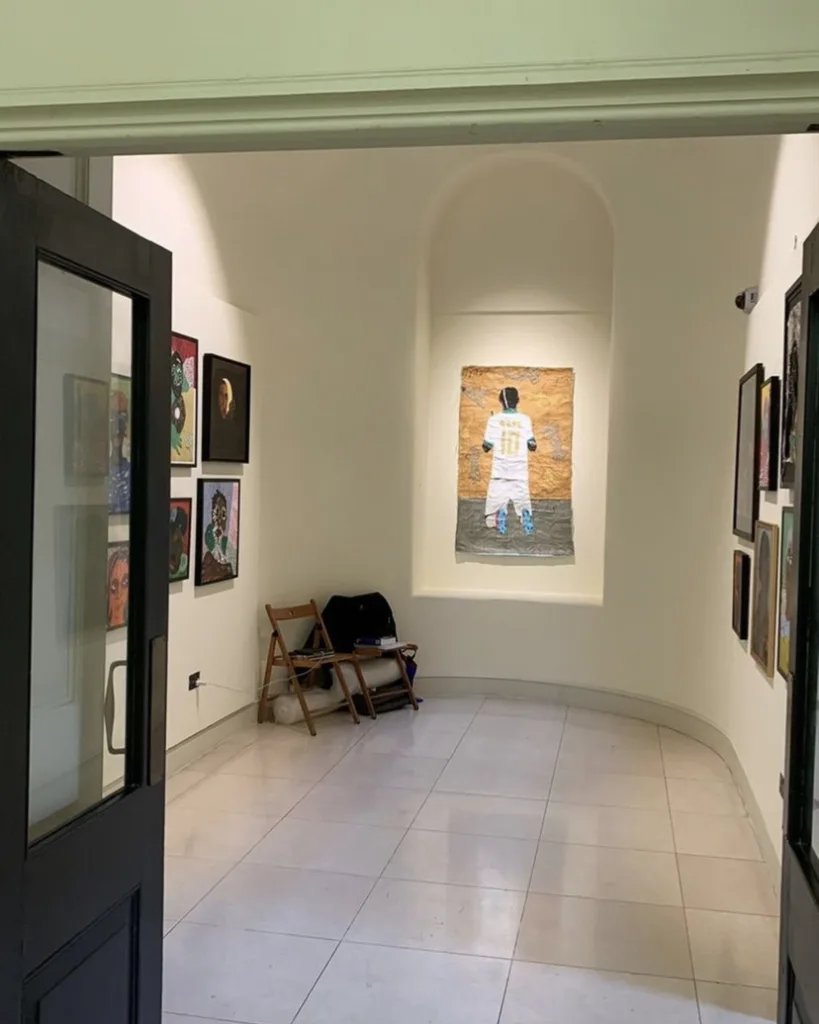
3. Sustainability:
Sustainability has become a major theme in the art world today. Art fairs are a major emitter in the art world’s carbon footprint, accounting for approximately one-third of a commercial gallery’s annual emissions. The main drivers of these emissions are air transportation of artworks, staff travel, venue energy consumption, and the waste of single-use materials. As the art world strives for sustainability, addressing art fair emissions is critical. Per the Financial Times, the art world takes a significant step towards sustainability, as leading fairs like Art Basel, Frieze, and Tefaf commit to reducing their carbon footprint by 50% by 2030, through their partnership with the Gallery Climate Coalition. Represented by 13 organizations like ARCO and The Armory Show, these fairs signed the Art Fair Co-Commitment Statement.
Artists and collectors are also prioritizing sustainable practices, acknowledging the environmental and ecological implications of art creation and consumption. This shift aligns with initiatives like upcycling and awareness-driven events, such as “Make Art, Save the Planet” by the Climate Week NYC, highlighting artistic expression’s vital role in climate advocacy.
Frieze:
Frieze has made notable strides in environmental sustainability, spearheading a shift towards eco-friendly practices in the art industry. The organization has eliminated its reliance on fossil fuels through the use of biofuel and battery storage, and has switched to energy-efficient LED lighting. Jon Ashman, Frieze’s CFO, notes that galleries and collectors increasingly prioritize organizations reducing their environmental footprint. To achieve this goal, Frieze has implemented comprehensive recycling systems and reuses gallery walls, lighting, and signage, aiming for near-zero waste by 2030. In collaboration with the Gallery Climate Coalition, Frieze promotes sustainable transportation through the #traintofrieze initiative, highlighting significant carbon savings. For instance, trains from Paris, Berlin, and Milan emit less than 10kg of carbon, compared to flights, which emit 160-790kg. Comparatively, industry experts advocate for localized approaches to enhance sustainability. Alice Audouin recommends featuring regional artists, citing Art Paris as a model, to reduce environmental impact and showcase unique local identities.

Art Vandalism:
Shifting to a more serious subject, on the 11th of October, 2024, National and regional museum leaders in the United Kingdom have issued an urgent open letter to end the vandalism of artworks carried out under the aegis of environmental activism and protests. This plea comes after a string of alarming incidents, including the infamous Heinz tomato soup attack on Vincent van Gogh’s Sunflowers at the National Gallery by three “Just Stop Oil” activists. The National Museum Directors’ Council has condemned these attacks, emphasizing that while they respect the right to protest, the damage caused to iconic artworks like Van Gogh’s Sunflowers, must stop. These protests have not only caused physical harm but also distress to visitors and staff, disrupting the mission to make art accessible to everyone.
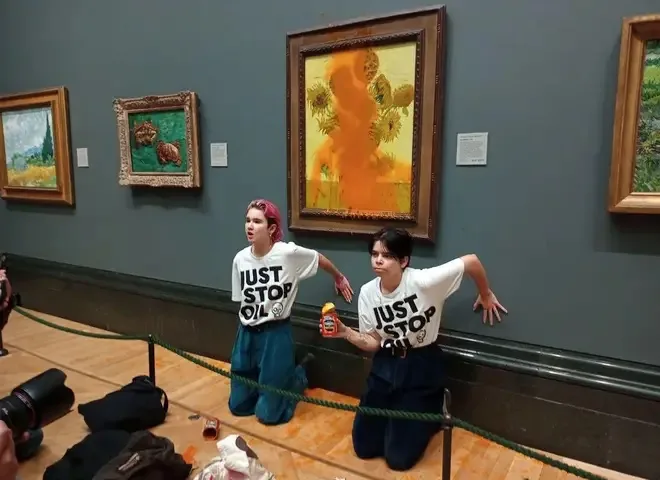
Starting October 18, 2024, the National Gallery in London will prohibit visitors from bringing liquids, except for baby formula, expressed milk, or prescription medications. Visitors will also be required to pass through metal detectors and have their bags inspected.
Sustainability and Virtual Reality:
As sustainability gains momentum across industries, the art world is no exception. Art fairs, known to be major contributors to emissions, present a significant challenge. So, how can they become more sustainable? One proposed solution is virtual reality technology. Companies like Vortic Art are leading the way, with founder Oliver Miro spearheading digital exhibitions that can cut emissions by up to 96% for fully virtual shows and nearly 50% for hybrid events. By minimizing the need for artwork travel and streamlining the journey from studio to collector, these innovations offer a greener alternative. While digital solutions won’t fully replace traditional art fairs, they can significantly reduce travel and shipping emissions, all while enhancing the exhibition experience. Likewise, major fairs like Frieze and Art Basel are exploring virtual reality to improve sustainability and viewing experiences.
Against this backdrop, online platforms like Artsy have become valuable for art fairs and galleries to present and sell artworks, spotlighting African art, including both emerging and established artists. These digital spaces create broader visibility for African artists and galleries, bringing their works into the international market, while promoting sustainability. As an example, ART X Lagos, holding from October 31st to November 3rd, 2024, features prominently on Artsy, offering curated collections, events, and exclusive partnerships that amplify African art for a global audience. This platform enables collectors and art enthusiasts worldwide to engage with the fair’s unique range of African genres and styles in a dynamic, digital environment.
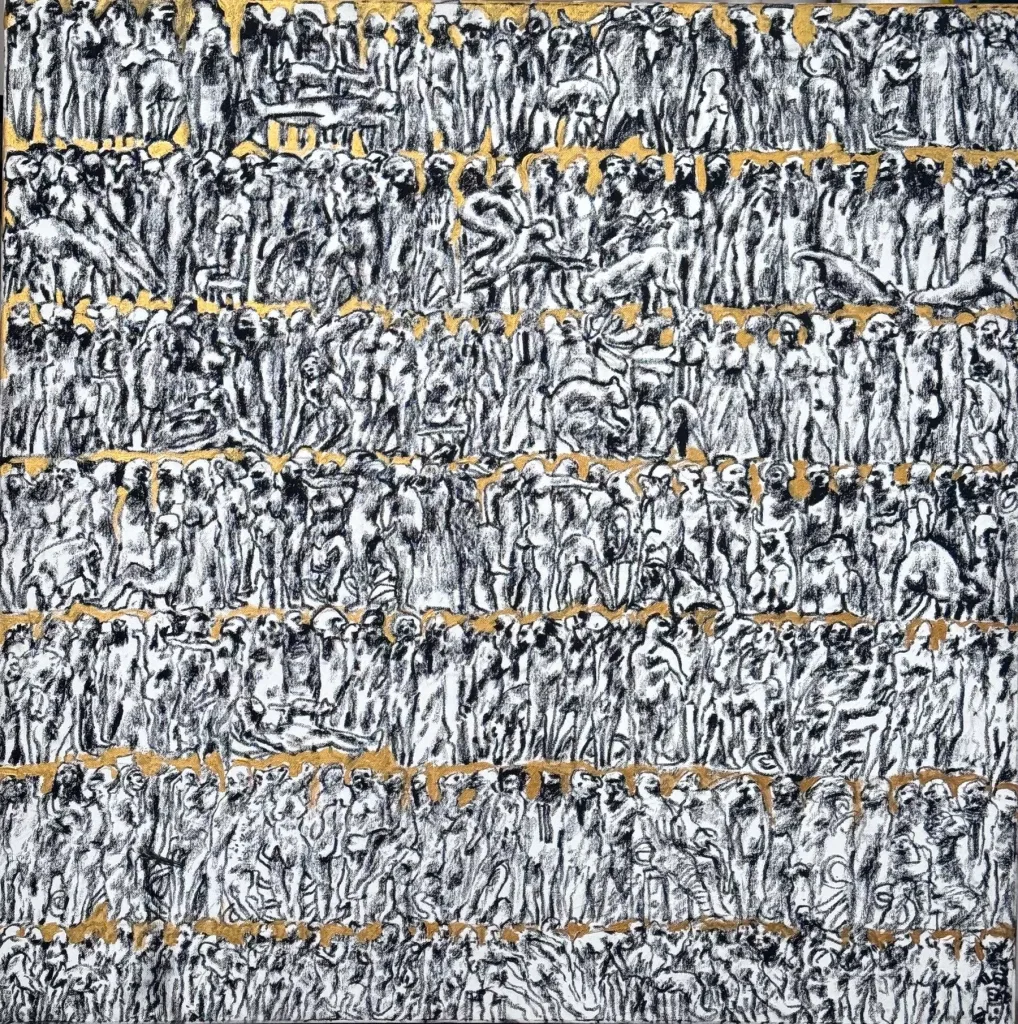
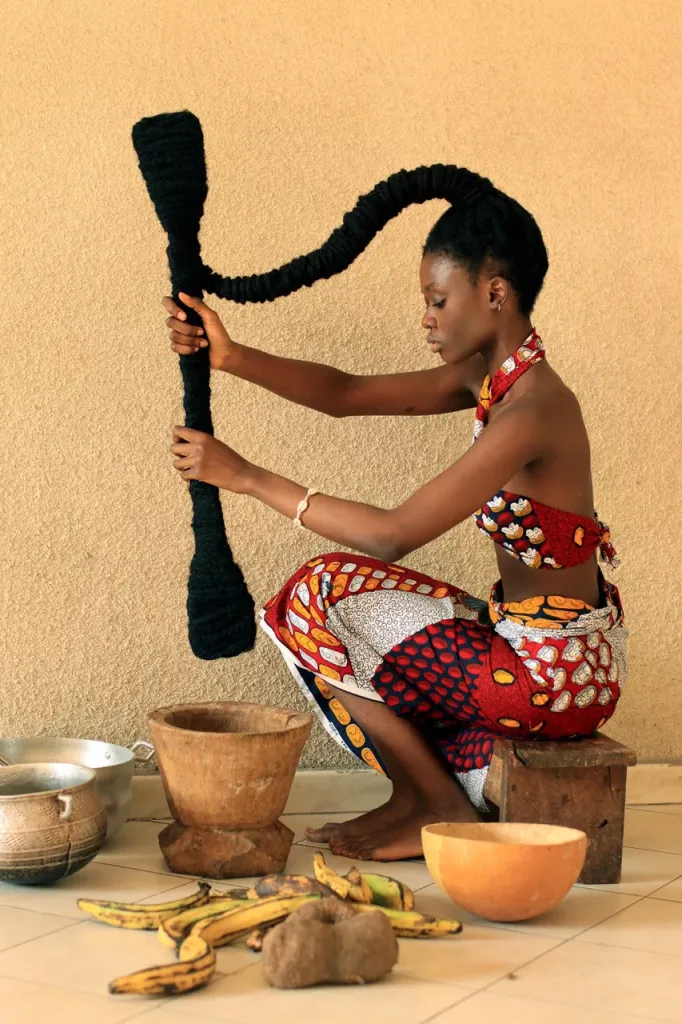
Similarly, AKAA (Also Known As Africa), a contemporary art fair in France dedicated to African perspectives, had a digital preview on Artsy on October 15, 2024, ahead of the fair’s dates from October 18-20. Galleries like Christopher Pearson, ARTCO Gallery, and Filafriques will leverage this platform to showcase artists such as Saidou Dicko, Abou Sidibé, and Reggie Khumalo, making African art more accessible to an international audience. Incredibly, the curated selection by Marion Guggenheim at AKAA Paris 2024 has generated notable interest, especially with highlighted pieces like Walking on Gold, II (2024) by Soly Cissé, Africa la mère du monde (2024) by Amani Bodo, Evening at the Palazzo I (2024) by Leila Rose Fanner, and African Kitchen (2022) by Laetitia Ky. Notably, African Kitchen has been tagged as an “Increased Interest” piece, spotlighting its unique appeal and growing popularity among viewers.
4. Technology & Art:
Digital art and the digitalization of art sales are revolutionizing traditional boundaries, offering artists opportunities to blend diverse disciplines, create innovative and unique works, and sell them virtually. As highlighted, platforms like Artsy have become essential marketplaces for both established and emerging artists, offering global reach and visibility. Through curated exhibitions and online events, Artsy enables collectors to discover diverse art styles and connect with artists worldwide.
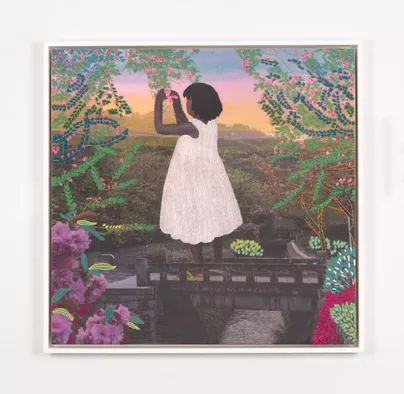

Notably, the Armory Show offered a comprehensive digital presence on Artsy, featuring a range of artist booths and insightful articles spotlighting the fair’s highlights. This online platform gave collectors and art enthusiasts an accessible way to experience the fair’s diversity, with booths showcasing works from renowned galleries and artists. Some featured works consisted of Joana Choumali’s The Overwhelming Sense of Feeling at Home (2024) and Ndidi Emefiele’s Mobility Lunch (2024); the former has already been sold, while the latter is currently listed with a “price on request” status, drawing significant collector interest.
In a similar way, at the 1-54 Contemporary African Art Fair, works by a diverse roster of artists were both exhibited and sold through Artsy. Highlights included pieces from Amina Agueznay, Alia Ali, Mous Lamrabat and Joana Choumali all showcased by Loft Art Gallery; as well as works by Januario Jano and Kwame Sousa (inter alia) with MOVART Gallery; and Theresa Musoke (with others) with Circle Art Gallery. Numerous other galleries also presented a rich array of contemporary African artists, connecting collectors with these powerful voices and unique stylistic expressions from across the continent.


Additional digital platforms, like Saatchi Art (affiliated with the Saatchi Gallery), Artnet’s online auctions, and Sotheby’s digital events, are continuously expanding access to art, connecting artists and collectors globally, and simplifying the art-buying experience.
House of Yatreda:
On another note for digital art, the Toledo Museum of Art in partnership with TMA Labs, presents House of Yatreda, a multisensory experience showcasing Ethiopia’s rich cultural heritage through contemporary digital art. Created by Yatreda, a family of Ethiopian artists, this immersive installation complements the Ethiopia at the Crossroads exhibition. The experience features an immersive display of four digital artworks from Yatreda’s “Abyssinian Queen” collection, a traditional Ethiopian coffee ceremony infused with artistic vision, and interactive experiences exploring Ethiopia’s history, legends, and folklore. Under the leadership of Creative Director Kiya Tadele, Yatreda reimagines the Abyssinian Empire, weaving history, cherished legends, and folklore together. The artwork invites reflection on the cyclical nature of history and a nation’s potential for resurgence.
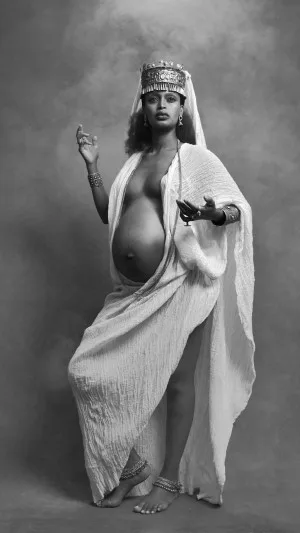
The “House of Yatreda” experience runs from the 17th of August to the 10th of November 2024, featuring three coffee ceremony performances. This innovative fusion of art, culture, and community invites visitors to explore Ethiopia’s heritage and contemplate its relevance to modern challenges.
Following this, an in-depth article will offer a close examination of Africa’s art scene in 2024, spotlighting its rising global recognition, while examining the ongoing issues of representation and revenue disparities in comparison to Western markets.


